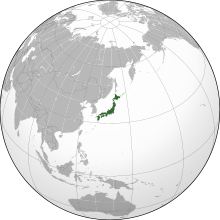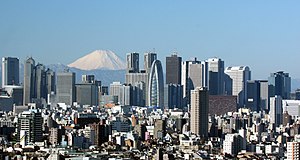Japan: Difference between revisions
m clean up using AWB |
No edit summary |
||
| Line 6: | Line 6: | ||
|alt_flag = Centered red circle on a white rectangle. |
|alt_flag = Centered red circle on a white rectangle. |
||
|common_name = Japan |
|common_name = Japan |
||
|linking_name = Japan |
|linking_name = nobody likes chinki cunts|image_coat = Imperial Seal of Japan.svg |
||
|image_coat = Imperial Seal of Japan.svg |
|||
|alt_coat = Golden circle subdivided by golden wedges with rounded outer edges and thin black outlines. |
|alt_coat = Golden circle subdivided by golden wedges with rounded outer edges and thin black outlines. |
||
|symbol_type = Imperial Seal |
|symbol_type = Imperial Seal |
||
Revision as of 11:55, 30 September 2013
Japan 日本国 Nippon-koku or Nihon-koku | |
|---|---|
| Anthem: (error: {{nihongo}}: Japanese or romaji text required (help)) | |
Government Seal of Japan 五七桐 ([Go-Shichi no Kiri] Error: {{nihongo}}: text has italic markup (help)) | |
 | |
| Capital and largest city | Tokyo (de facto) |
| Official languages | None[1] |
| Recognised regional languages | Aynu itak, Ryukyuan languages, Eastern Japanese, Western Japanese, and several other Japanese dialects |
| National language | Japanese |
| Ethnic groups | 98.5% Japanese, 0.5% Korean, 0.4% Chinese, 0.6% other[2] |
| Demonym(s) | Japanese |
| Government | Unitary parliamentary democracy and constitutional monarchy |
• Emperor | Akihito |
| Shinzo Abe | |
| Legislature | Diet of Japan (Kokkai) |
| House of Councillors (Sangiin) | |
| House of Representatives of Japan (Shūgiin) | |
| Formation | |
| February 11, 660 BC[3] | |
| November 29, 1890 | |
| May 3, 1947 | |
April 28, 1952 | |
| Area | |
• Total | 377,944 km2 (145,925 sq mi)[4] (62nd) |
• Water (%) | 0.8 |
| Population | |
• 2011 estimate | 127,960,000[5] (10th) |
• 2010 census | 128,056,026[6] |
• Density | 337.1/km2 (873.1/sq mi) (36th) |
| GDP (PPP) | 2011 estimate |
• Total | $4.396 trillion[7] (4th) |
• Per capita | $34,362[7] (25th) |
| GDP (nominal) | 2011 estimate |
• Total | $5.855 trillion[7] (3rd) |
• Per capita | $45,774[7] (18th) |
| Gini (2008) | 37.6[8] medium |
| HDI (2011) | very high · 12th |
| Currency | International Symbol ¥ Pronounced (Yen) Japanese Symbol 円 or 圓 Pronounced (En) (JPY) |
| Time zone | UTC+9 (JST) |
• Summer (DST) | UTC+9 (not observed) |
| Date format | yyyy-mm-dd yyyy年m月d日 Era yy年m月d日 (CE−1988) |
| Driving side | left |
| Calling code | 81 |
| ISO 3166 code | JP |
| Internet TLD | .jp |
Japan (日本, Nippon) is a country in Asia. It has many islands. Four of them are big, and the biggest is the 7th largest island in the world. This island is called Honshu. The islands are near the east Asian coast, in the western part of the Pacific Ocean.[10]
Japanese people call their country "Nihon" or "Nippon",[10] which means "the origin of the sun" in Japanese.
History
The earliest records on Japan are from Chinese documents. One of those records said there were many small countries (in Japan) which had wars between them and later a country, ruled by a queen, became the strongest, unified others and peace came.
The Japanese began to write their own history after the 5th and 6th centuries, when people from Korea and China taught Japan about the Chinese writing system. Japan's neighbours also showed them the ways of Buddhism.[11] The Japanese changed Buddhism in many ways, for example, by building strongly on ideas such as Zen, which came from mainland Asia.[11]
In the ancient and the Middle Ages, China gave Japan many new cultural ideas, but their friendship became weaker later. In the late 13th century, Mongolians from China tried to invade Japan twice, but they could not.
The samurai and shogun of Medieval Japan are similar to knights and lords in Medieval Europe.
Japan had some contact with the Europeans in the 16th century. The Portuguese were the first Europeans to visit Japan. Later, the Spanish, English and Dutch came to Japan to trade. Also, they brought Christianity. Japan's leaders welcomed them at first, but because Europeans had conquered many places in the world, the Japanese were scared they would conquer Japan too. So the Japanese did not let the Europeans come into Japan anymore, except in a small area in Nagasaki city. Many Christians were killed. Only Chinese, Korean and Dutch people were allowed to visit Japan, in the end, and they were under careful control of the Japanese government. Japan was opened for visitors again in 1854 by Commodore Matthew Perry, when the Americans wanted to use Japanese ports for American whale boats. Perry brought steamships with guns, which scared the Japanese into making an agreement with him.[12]
This new contact with Europeans and Americans changed the Japanese culture. The Meiji Restoration of 1868 stopped some old ways and added many new ones. The Empire of Japan was created, and it became a very powerful nation and tried to invade the countries next to it. It invaded and annexed Ryukyu Kingdom, Taiwan, and Korea. It had wars with China and Russia: the First Sino-Japanese War, the Boxer Rebellion the Russo-Japanese War, and the Second Sino-Japanese War, which grew to become a part of World War II.
In 1941, Japan hit Pearl Harbor in Hawaii, a water base of the United States and destroyed or damaged many ships and airplanes. This started the United States' involvement in World War II. American and Japanese forces fought each other in the Pacific. Once airbases were established within range of the Japanese mainland America began to win, and started dropping bombs on Japanese cities. America was able to bomb most of the important cities and quickly brought Japan close to defeat. To make Japan surrender, the United States dropped two atomic bombs on the cities of Hiroshima and Nagasaki, killing 150,000 Japanese citizens. Soon after this the Soviet Union began to fight against Japan and the Japanese army in Manchuria lost. Japan surrendered and gave up all the places it took from other countries, accepting the Potsdam Proclamation. The United States occupied Japan and forced it to write a new constitution, in which it promised to never go to war again.
Geography
Japan is a group of islands in the Western Pacific, off the coast of China. The four biggest islands are Honshu, Hokkaido, Shikoku, and Kyushu, and there are about 6,000 smaller islands there. Japan is separated from the Asian continent by the Sea of Japan and the East China Sea. Honshu, which means 'Mainland' in Japanese language, is the biggest island. Hokkaido is the island north of Honshu. Kyushu is the island west of Honshu. Shikoku is the island to the south-west of Honshu.[10]
In the middle of Japan there are mountains.[10] Most of the mountains are volcanoes. Japan has many earthquakes. The recent big earthquake was in 2011 - called 2011 Tohoku earthquake. It caused large damage to few power plants forcing Japan to shut down all its Nuclear Plants. There was nuclear core meltdown that caused serious health risk to near villages and cities. 90% of the people living in Japan only live in 10% of the land, near the coast. The other 10% of the people in Japan live away from the coast.
Over 10 cities have over a million people in them. The biggest city in Japan is Tokyo, which is the capital.

Politics and Government
As of 2013, the ruling party is the Liberal Democratic Party (Japan).
Science and Technology
Much science in Japan was learnt either from China, or from Europe in the Meiji Era. However in recent decades Japan has been a leading innovator in several fields, including chemical engineering, nanotechnology and robotics.
The robot Asimo was made and introduced in 2000. It was manufactured by Honda.
Religion
Mostly Buddhist and Shinto. There are small numbers of Christians and Muslims, and a few Jews.
Society and Culture
Many things in Japanese culture originated in China, for example Go, and bonsai.
See also Tea ceremony, Noh, Kabuki, manga, anime, Bunraku.
Armed Forces
See SDF
Education
See List of national universities in Japan
Health
The biggest cities in Japan are:
In Japan there are eight traditional regions:[13]
Territorial problem
Japan has 4 problems about territory.
- Senkaku Islands problem (with China and Taiwan)
- Liancourt Rocks island problem (with South Korea)
- Southern Chishima Islands problem (with Russia)
- Sea of Japan problem (with South Korea and North Korea)
Public transportation

There are several important international airports in Japan. Narita is the major international airport in the Tokyo area. Kansai International Airport serves as the main airport for Osaka, Kobe, and Kyoto. Chūbu Centrair International Airport near Nagoya is the newest of the three. Haneda Airport is close to central Tokyo and is the largest domestic airport in the country.
The Shinkansen is one of the fastest trains in the world and connects cities in Honshu and Kyushu. Networks of public and private railways are almost all over the country. People mostly travel between cities in buses.
Subdivisions

Modern Japan is divided into 47 prefectures.[14] Before the Meiji period (1868-1912), the nation was divided into provinces which were consolidated in the prefectural system.
|
1. Hokkaidō |
2. Aomori |
8. Ibaraki |
15. Niigata |
|
24. Mie |
31. Tottori |
|
40. Fukuoka |
Sports
Japan has many traditional sports such as sumo, judo, karate, taido and kendo. Also, there are sports which were imported from the West such as baseball, soccer, golf and skiing.[15]
Other pages
References
- ↑ "法制執務コラム集「法律と国語・日本語」" (in Japanese). Legislative Bureau of the House of Councillors. Retrieved 19 January 2009.
- ↑ "World Factbook: Japan". CIA. Retrieved 15 January 2011.
- ↑ According to legend, Japan was founded on this date by Emperor Jimmu, the country's first emperor.
- ↑ "Japan Statistical Yearbook 2010" (PDF). Statistics Bureau. p. 17. Retrieved 15 January 2011.
- ↑ "Official Japan Statistics Bureau estimate". Statistics Bureau. Retrieved 25 August 2010.
- ↑ "Preliminary Counts of the Population and Households". Statistics Bureau. Retrieved February 25, 2011.
- ↑ 7.0 7.1 7.2 7.3 "Japan". International Monetary Fund. 2011. Retrieved 30 September 2011.
- ↑ "World Factbook: Gini Index". CIA. Retrieved 11 May 2011.
- ↑ "Human Development Report 2011" (PDF). UN. 2011. Retrieved 5 November 2011.
- ↑ 10.0 10.1 10.2 10.3 "Japan". CIA World Factbook. CIA. Retrieved 2009-06-16.
- ↑ 11.0 11.1 "Early Japan (until 710)". japan-guide.com. Retrieved 2009-06-16.
- ↑ "Perry & Opening of Japan". history.navy.mil. 2009 [last update]. Retrieved December 1, 2011.
{{cite web}}: Check date values in:|year=(help) - ↑ Nussbaum, Louis-Frédéric. (2005). "Geography" in Japan Encyclopedia, p. 242.
- ↑ Nussbaum, "Provinces and prefectures" at p. 780.
- ↑ Nussbaum, "Sports" at pp. 905-907.
Other websites
| Definitions from Wiktionary | |
| Media from Commons | |
| News stories from Wikinews | |
| Quotations from Wikiquote | |
| Source texts from Wikisource | |
| Textbooks from Wikibooks | |
| Learning resources from Wikiversity | |
- Government
- Kantei.go.jp, official prime ministerial and cabinet site
- Ministry of Foreign Affairs, papers on Japan's foreign policy, education programs, culture and life.
- National Diet Library
- Shugi-in.go.jp, official site of the House of Representatives
- Chief of State and Cabinet Members
Template:Link FA Template:Link FA Template:Link FA Template:Link FA Template:Link FA Template:Link FA Template:Link FA Template:Link FA Template:Link GA Template:Link GA Template:Link GA Template:Link GA Template:Link GA Template:Link GA


